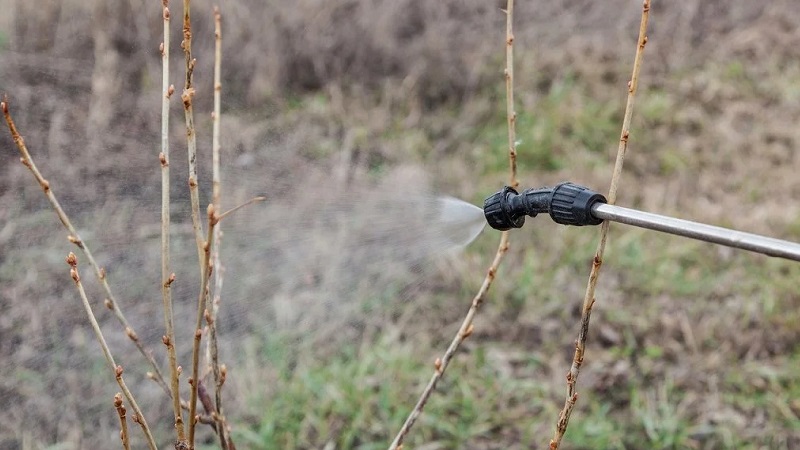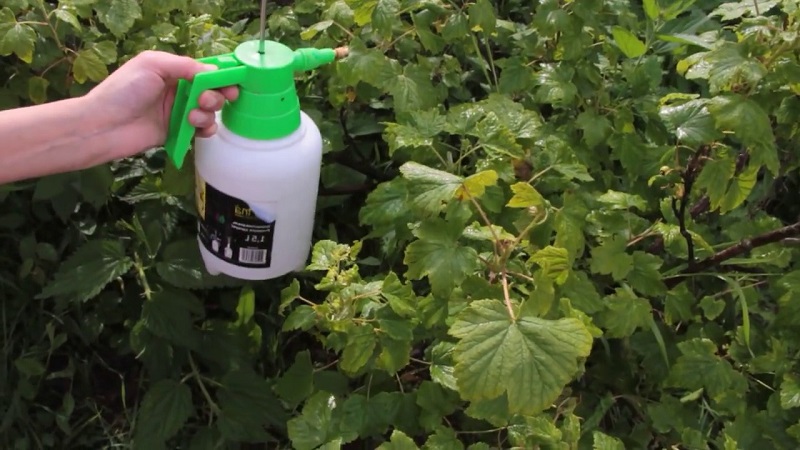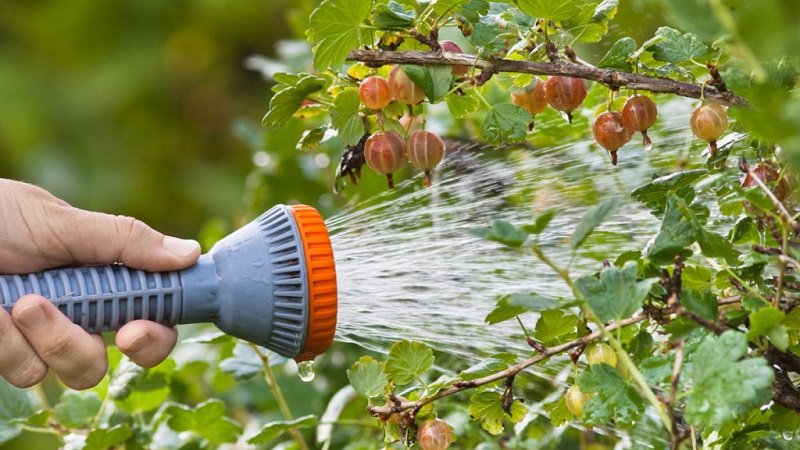How to process gooseberries in spring and summer against diseases and pests
The gooseberry is easy to care for, but it is prone to infection with powdery mildew, rust, anthracnose and septoria. Caterpillars, aphids, mites and moths feed on sweet and sour berries and juicy foliage. To protect plantings from damage, it is recommended to carry out preventive treatment in early spring, observing the work schedule. What remedies are suitable for protecting gooseberries before the buds swell, during the period of green mass gain, flowering and fruiting, read the article.
The content of the article
Treatment of gooseberries from diseases and pests in early spring
In the spring, gooseberries are one of the first to emerge from the dormant period., therefore, needs the attention of a gardener. First of all, it is examined and dry and frozen branches are removed. Plant residues are removed from the site, and the bushes are sprayed in order to prevent diseases and pests.

Before flowering
It is difficult to determine the specific dates for processing gooseberries from diseases and pests. Experienced gardeners recommend focusing on the vegetative period of the plant and start processing before bud break... The air temperature should be at least + 5 ° С and be kept for several days. Compliance with the terms of preventive treatment is also associated with the beginning of the life of the caterpillars.
Before the kidneys swell collect mite buds, remove damaged and crooked shoots, spill gooseberries with hot water for prevention powdery mildew... For the prevention of anthracnose, the bushes are treated with the preparations "Kuprozan" or "Khomycin" once.
During the period of swelling of the buds, the bushes are sprayed with a 1% solution of Bordeaux liquid against leaf spot (anthracnose, septoria, rust). Treatment against ticks is carried out with "Kleschevit", "Aktofit", against powdery mildew - "Tiovit Jet". Preventive spraying against moth and caterpillars is carried out with the preparations Kinmix, Inta-Ts-M, Iskra, Aktellik, Iskra-M. After stable warm weather is established, the plantings are treated with the biological products "Bitoxibacillin" and "Fitosporin". Shoot aphids are destroyed with 1% solution of "Fufanon" or "Decis". Some gardeners prefer to spray their bushes with biological Green Soap.
During the budding period (“rose bud” phase), the plantings are re-processed against caterpillars, moths and ticks. For the prevention of powdery mildew, copper-containing preparations are used (Bordeaux liquid, copper sulphate, "Oxyhom", "HOM"), as well as Topaz, Skor, Tiovit Jet and colloidal sulfur.
Preventive treatment is performed in early spring against a bud mite that tolerates double leaves. Means "Karate" (0.2%) and "Decis" (0.1%) are effective. The bushes are sprayed once.
After flowering
How to spray gooseberries after flowering? At this time, small ovaries appear on the branches, therefore it is forbidden to treat the plant with chemicals and biological insecticides... Such preparations are very harmful to bees and other pollinating insects.
For treating bushes against diseases use folk remedies:
- For 10 liters of water, take 1 kg of wood ash and 50 g of soap shavings. Ash is poured with water and insisted for 3-4 days. Before use, stir in the soap for viscosity and stickiness. Instead of infusing, the solution can be boiled, cooled and used for spraying three times every other day.
- Humus is diluted with water 1: 3 and insisted for three days.The resulting mixture is diluted with water 1: 2, the bushes are watered immediately after flowering and after harvesting.
- 200 g of onion husks are poured into 10 liters of boiling water and insisted for two days. The bushes are sprayed immediately after flowering and after harvest.
- For 10 liters of water, take 1 liter of kefir and spray the gooseberries three times every three days. The remedy is effective against fungal infections.
- Gooseberry anti-rust treatment is performed after flowering. For this use "Fitosporin" or 1% solution of Bordeaux liquid. In case of severe infection, the treatment is repeated after 10 days.
- A kidney mite is destroyed with this solution: 300 g of garlic, 1 tbsp. l. mustard, 2 tbsp. l. tar, 200 g of onion husks, 10 liters of water. The bushes are sprayed twice with an interval of 3-4 days.

Rules for processing gooseberries in spring
For effective spring treatment of gooseberries against pests and diseases it is recommended to follow a number of rules:
- When preparing solutions based on chemicals, it is important to observe safety precautions and work in overalls, goggles, gloves and a respirator. The same rule applies to handling plantings.
- Spraying is carried out exclusively in the morning after the dew dries or in the evening in dry and calm weather. Under the scorching rays of the sun, the solution quickly evaporates from the surface of the leaves, and the preparations lose their effectiveness. After rain, a thin film of water remains on the leaves, which reduces the effect of active substances and the concentration of the solution.
- Processing is carried out strictly after the spring pruning of the bushes. Spraying additionally protects the cut points.
- Before using a chemical preparation, it is recommended to study the instructions, paying special attention to the frequency of treatments and the period of action of the active substance.
- At each stage, you can use the same drugs, but it is better to alternate with new drugs to prevent addiction.
- Before flowering, no more than two treatments are carried out; after flowering, their frequency is increased if necessary.
- The prepared solutions are passed through a filter so that microparticles do not clog the spray holes.
- Powder preparations are dissolved in water at room temperature, but for copper sulfate it is better to use hot water (+ 40 ... + 50 ° С).
- Filtered or settled water is used to dissolve biological preparations.
- The bushes themselves and the trunk circle are carefully sprayed with solutions, since many pests and fungal spores winter in the ground.
- If, after spraying with a contact insecticide, it immediately rains, the treatment is repeated the next day. This rule does not apply to systemic drugs. The active substances penetrate into plant tissues in the first 2-3 hours after treatment.
Gardeners recommend not to increase the chemical load on the plant and take a break 5-7 days between fungicide and insecticide treatments.
Treating gooseberries from pests in summer
How to treat bushes from pests in the summer? During the period of active growth and fruiting, preventive treatment is continued gooseberry from insects and diseases. At this time, it is recommended to use biological drugs and folk remedies. Chemicals are used in exceptional cases - with severe infection of the plant.
How to process in summer
Depending on the varieties gooseberry berries ripen from June to early August... Some gardeners choose to literally grapple with problems with their bare hands. Having found the first symptoms, they remove leaves and branches, thereby reducing the focus of infection.

List of popular biologics:
- «Nemabakt"Contains predatory nematodes and bacteria that penetrate the larvae, begin to actively multiply in them and feed on tissues. This drug has established itself as one of the most effective against glass caterpillars. It can be found in gardening stores in the form of sponges. One sponge is taken for 10 liters of water. Consumption - 10 liters of solution per hundred square meters.
- «Lepidocide»Effective against lepidoptera and their larvae. The drug contains protein crystals that dissolve in alkali and adversely affect the digestive system of pests. The tool is used to destroy moth caterpillars. For 10 liters of water, take 20-30 g of powder or suspension.
- «Bitoxibacillin»Effective against spider mites, moths and aphids. The principle of action of the drug is the same as that of "Lepidocide". It contains bacteria that form spores in the intestines. For 10 liters of water, 80-100 g of the drug is enough.
- «Fitosporin»Sold as paste, emulsion and powder. It has a systemic effect, penetrating into plant tissues. Effective against powdery mildew, scab and rust. Economical consumption - 200 g is enough to process an entire gooseberry plantation for the entire summer period.
- «Pharmayod»Contains iodine, which is effective against bacteria, fungi and viruses. When reacted with water, it forms active oxygen, which adversely affects the pathogenic microflora. Gooseberry processing is carried out after pinching and pruning. For 10 liters - 100 ml of the product.
- «HB-101»- Japanese growth stimulator based on extracts of pine, plantain, cypress, Japanese cedar. The active ingredient - silicon dioxide - strengthens the cell walls and stimulates their growth, increases resistance to viral and fungal infections. For 10 liters of water - 10 drops. Spraying is performed after shedding flowers on the ovaries.
Folk recipes:
- For the prevention of diseases and the fight against aphids: 40 drops of brilliant green or iodine, 50 g of shavings of laundry soap per 10 liters of water. The frequency of processing is 1-2 times with an interval of 5-7 days.
- A universal remedy for diseases and insects: 10 g of boric acid, a bottle of iodine, pharmacy birch tar, ammonia, fir oil for 40 liters of water. Dissolve a glass of the mixture in 10 liters of water and spray the bushes in a respirator. The frequency of treatment depends on the extent of the lesion. It is often enough 1-2 times after 14 days.
- For the destruction of aphids: 1 tbsp. l. anti-flea shampoo for 10 liters of water. Treat once.
- For fungal infections: 20 Trichopolum tablets per 10 liters of water. The frequency of treatment is 1-2 times in a week.
When there are already berries
Can I spray gooseberries when there are already berries? During the period of active fruiting and harvesting, chemical agents should not be used.... It is allowed to spray the bushes with biological products and folk remedies. Berries damaged by a moth are cut off by hand, the caterpillars are shaken off the branches, after having spread an unnecessary piece of cloth under the bush, which is then not a pity to burn.

In order to prevent the spread of insects, gooseberries are abundantly sprayed with clean water. and powdered with wood ash. The procedure is repeated several times as the ash is washed off by the rain.
Another effective insect repellent - 1 kg of tobacco dust per 10 liters of water. The solution is insisted for 2-3 days, filtered and treated with bushes 2-3 times every seven days.
To scare away pests use an infusion of dry mustard... For 5 liters of water, take 3 tbsp. l. mustard powder and insist 48 hours. Then filter and add 50 g of shavings of laundry soap. The frequency of treatments is 3-4 times after 10 days.
Reference. There are gooseberry varieties with powdery mildew resistance: Ural grapes, Senator, Harlequin, Mashenka, Kolobok, Grushenka, Finnish, African, Yubileiny.
Conclusion
The period and frequency of treatment of gooseberries from diseases and insect pests depend on weather conditions, the growing season and the degree of damage to the plant. Chemicals are used in early spring before flowering and ovary formation. By the time of harvest, toxic substances will have time to decompose and leave plant tissues. After flowering and active fruiting, gooseberries are treated with biological products and folk remedies. Berries after such treatments are suitable for human consumption.